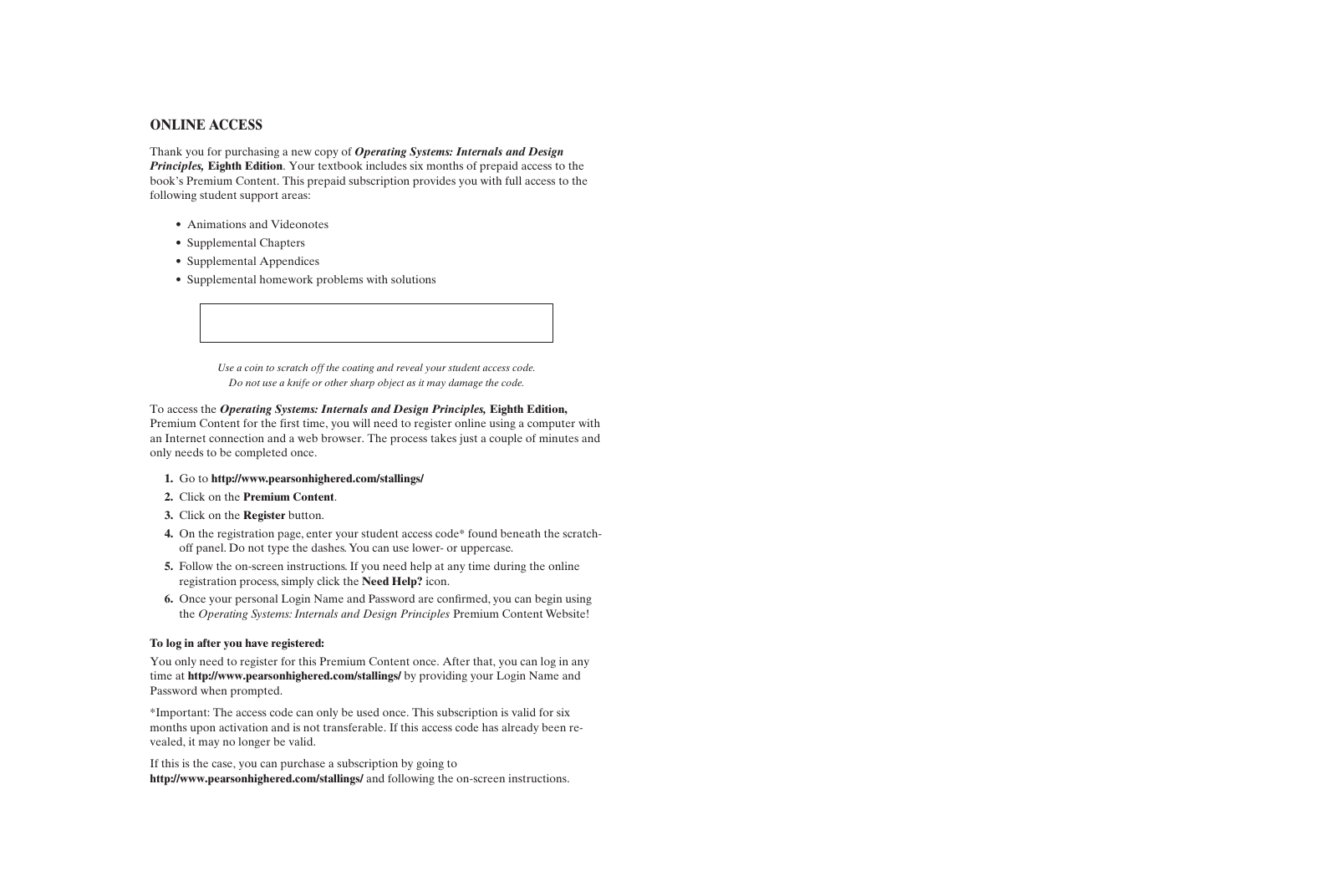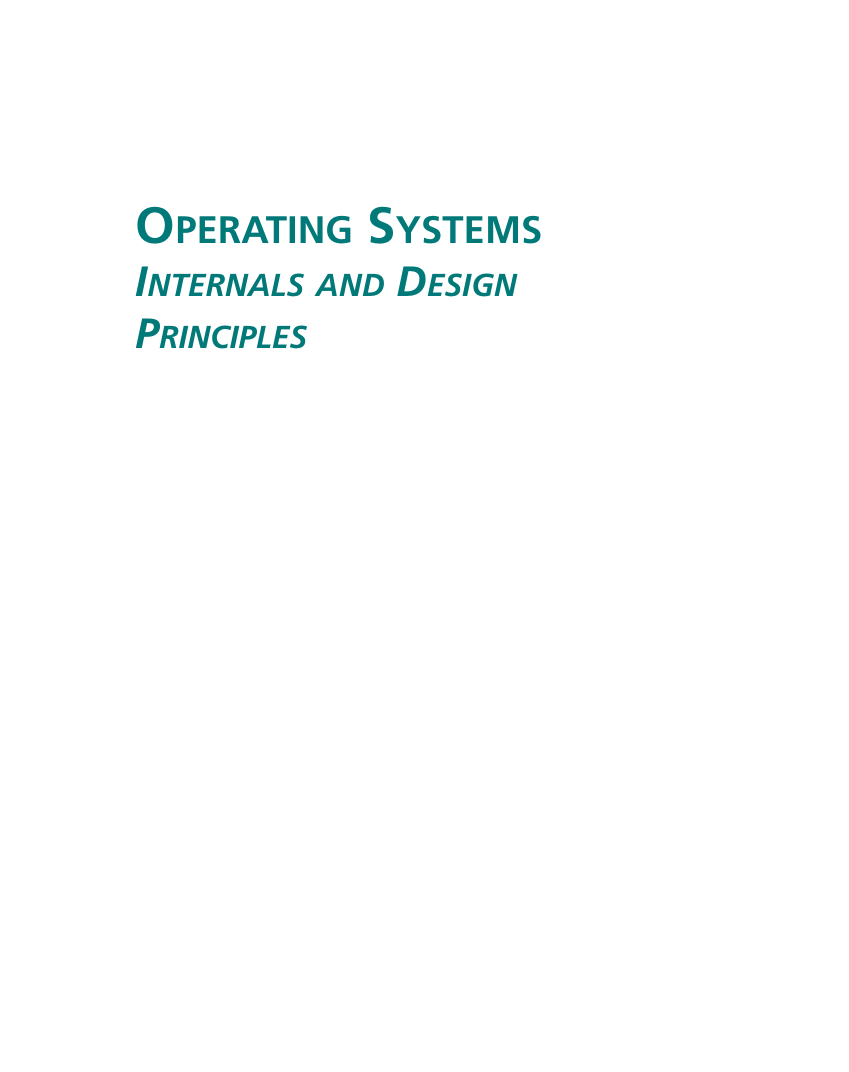Cover
Copyright
Contents
Online Resources
VideoNotes
Preface
About the Author
0 Guide for Readers and Instructors
0.1 Outline of this Book
0.2 Example Systems
0.3 A Roadmap for Readers and Instructors
0.4 Internet and Web Resources
PART 1 BACKGROUND
1 Computer System Overview
1.1 Basic Elements
1.2 Evolution of the Microprocessor
1.3 Instruction Execution
1.4 Interrupts
1.5 The Memory Hierarchy
1.6 Cache Memory
1.7 Direct Memory Access
1.8 Multiprocessor and Multicore Organization
1.9 Recommended Reading
1.10 Key Terms, Review Questions, and Problems
1A Performance Characteristics of Two-Level Memories
2 Operating System Overview
2.1 Operating System Objectives and Functions
2.2 The Evolution of Operating Systems
2.3 Major Achievements
2.4 Developments Leading to Modern Operating Systems
2.5 Fault Tolerance
2.6 OS Design Considerations for Multiprocessor and Multicore
2.7 Microsoft Windows Overview
2.8 Traditional UNIX Systems
2.9 Modern UNIX Systems
2.10 Linux
2.11 Android
2.12 Recommended Reading and Animations
2.13 Key Terms, Review Questions, and Problems
PART 2 PROCESSES
3 Process Description and Control
3.1 What Is a Process?
3.2 Process States
3.3 Process Description
3.4 Process Control
3.5 Execution of the Operating System
3.6 UNIX SVR4 Process Management
3.7 Summary
3.8 Recommended Reading and Animations
3.9 Key Terms, Review Questions, and Problems
4 Threads
4.1 Processes and Threads
4.2 Types of Threads
4.3 Multicore and Multithreading
4.4 Windows 8 Process and Thread Management
4.5 Solaris Thread and SMP Management
4.6 Linux Process and Thread Management
4.7 Android Process and Thread Management
4.8 Mac OS X Grand Central Dispatch
4.9 Summary
4.10 Recommended Reading
4.11 Key Terms, Review Questions, and Problems
5 Concurrency: Mutual Exclusion and Synchronization
5.1 Principles of Concurrency
5.2 Mutual Exclusion: Hardware Support
5.3 Semaphores
5.4 Monitors
5.5 Message Passing
5.6 Readers/Writers Problem
5.7 Summary
5.8 Recommended Reading and Animations
5.9 Key Terms, Review Questions, and Problems
6 Concurrency: Deadlock and Starvation
6.1 Principles of Deadlock
6.2 Deadlock Prevention
6.3 Deadlock Avoidance
6.4 Deadlock Detection
6.5 An Integrated Deadlock Strategy
6.6 Dining Philosophers Problem
6.7 UNIX Concurrency Mechanisms
6.8 Linux Kernel Concurrency Mechanisms
6.9 Solaris Thread Synchronization Primitives
6.10 Windows 7 Concurrency Mechanisms
6.11 Android Interprocess Communication
6.12 Summary
6.13 Recommended Reading and Animations
6.14 Key Terms, Review Questions, and Problems
PART 3 MEMORY
7 Memory Management
7.1 Memory Management Requirements
7.2 Memory Partitioning
7.3 Paging
7.4 Segmentation
7.5 Summary
7.6 Recommended Reading and Animations
7.7 Key Terms, Review Questions, and Problems
7A Loading and Linking
8 Virtual Memory
8.1 Hardware and Control Structures
8.2 Operating System Software
8.3 UNIX and Solaris Memory Management
8.4 Linux Memory Management
8.5 Windows Memory Management
8.6 Android Memory Management
8.7 Summary
8.8 Recommended Reading and Animations
8.9 Key Terms, Review Questions, and Problems
PART 4 SCHEDULING
9 Uniprocessor Scheduling
9.1 Types of Processor Scheduling
9.2 Scheduling Algorithms
9.3 Traditional UNIX Scheduling
9.4 Summary
9.5 Recommended Reading and Animations
9.6 Key Terms, Review Questions, and Problems
10 Multiprocessor, Multicore, and Real-Time Scheduling
10.1 Multiprocessor and Multicore Scheduling
10.2 Real-Time Scheduling
10.3 Linux Scheduling
10.4 UNIX SVR4 Scheduling
10.5 UNIX FreeBSD Scheduling
10.6 Windows Scheduling
10.7 Summary
10.8 Recommended Reading
10.9 Key Terms, Review Questions, and Problems
PART 5 INPUT/OUTPUT AND FILES
11 I/O Management and Disk Scheduling
11.1 I/O Devices
11.2 Organization of the I/O Function
11.3 Operating System Design Issues
11.4 I/O Buffering
11.5 Disk Scheduling
11.6 RAID
11.7 Disk Cache
11.8 UNIX SVR4 I/O
11.9 Linux I/O
11.10 Windows I/O
11.11 Summary
11.12 Recommended Reading and Animations
11.13 Key Terms, Review Questions, and Problems
12 File Management
12.1 Overview
12.2 File Organization and Access
12.3 B-Trees
12.4 File Directories
12.5 File Sharing
12.6 Record Blocking
12.7 Secondary Storage Management
12.8 UNIX File Management
12.9 Linux Virtual File System
12.10 Windows File System
12.11 Android File Management
12.12 Summary
12.13 Recommended Reading
12.14 Key Terms, Review Questions, and Problems
PART 6 EMBEDDED SYSTEMS
13 Embedded Operating Systems
13.1 Embedded Systems
13.2 Characteristics of Embedded Operating Systems
13.3 Embedded Linux
13.4 TinyOS
13.5 Recommended Reading
13.6 Key Terms, Review Questions, and Problems
14 Virtual Machines
14.1 Approaches to Virtualization
14.2 Processor Issues
14.3 Memory Management
14.4 I/O Management
14.5 VMware ESXi
14.6 Microsoft Hyper-V and Xen Variants
14.7 Java VM
14.8 Linux VServer Virtual Machine Architecture
14.9 Android Virtual Machine
14.10 Summary
14.11 Recommended Reading
14.12 Key Terms, Review Questions, and Problems
15 Operating System Security
15.1 Intruders and Malicious Software
15.2 Buffer Overflow
15.3 Access Control
15.4 UNIX Access Control
15.5 Operating Systems Hardening
15.6 Security Maintenance
15.7 Windows Security
15.8 Summary
15.9 Recommended Reading
15.10 Key Terms, Review Questions, and Problems
16 Distributed Processing, Client/Server, and Clusters
16.1 Client/Server Computing
16.2 Distributed Message Passing
16.3 Remote Procedure Calls
16.4 Clusters
16.5 Windows Cluster Server
16.6 Beowulf and Linux Clusters
16.7 Summary
16.8 Recommended Reading
16.9 Key Terms, Review Questions, and Problems
APPENDICES
Appendix A: Topics in Concurrency
Appendix B: Programming and Operating System Projects
References
Credits
Index
A
B
C
D
E
F
G
H
I
J
K
L
M
N
O
P
Q
R
S
T
U
V
W
X
Z
















 2023年江西萍乡中考道德与法治真题及答案.doc
2023年江西萍乡中考道德与法治真题及答案.doc 2012年重庆南川中考生物真题及答案.doc
2012年重庆南川中考生物真题及答案.doc 2013年江西师范大学地理学综合及文艺理论基础考研真题.doc
2013年江西师范大学地理学综合及文艺理论基础考研真题.doc 2020年四川甘孜小升初语文真题及答案I卷.doc
2020年四川甘孜小升初语文真题及答案I卷.doc 2020年注册岩土工程师专业基础考试真题及答案.doc
2020年注册岩土工程师专业基础考试真题及答案.doc 2023-2024学年福建省厦门市九年级上学期数学月考试题及答案.doc
2023-2024学年福建省厦门市九年级上学期数学月考试题及答案.doc 2021-2022学年辽宁省沈阳市大东区九年级上学期语文期末试题及答案.doc
2021-2022学年辽宁省沈阳市大东区九年级上学期语文期末试题及答案.doc 2022-2023学年北京东城区初三第一学期物理期末试卷及答案.doc
2022-2023学年北京东城区初三第一学期物理期末试卷及答案.doc 2018上半年江西教师资格初中地理学科知识与教学能力真题及答案.doc
2018上半年江西教师资格初中地理学科知识与教学能力真题及答案.doc 2012年河北国家公务员申论考试真题及答案-省级.doc
2012年河北国家公务员申论考试真题及答案-省级.doc 2020-2021学年江苏省扬州市江都区邵樊片九年级上学期数学第一次质量检测试题及答案.doc
2020-2021学年江苏省扬州市江都区邵樊片九年级上学期数学第一次质量检测试题及答案.doc 2022下半年黑龙江教师资格证中学综合素质真题及答案.doc
2022下半年黑龙江教师资格证中学综合素质真题及答案.doc